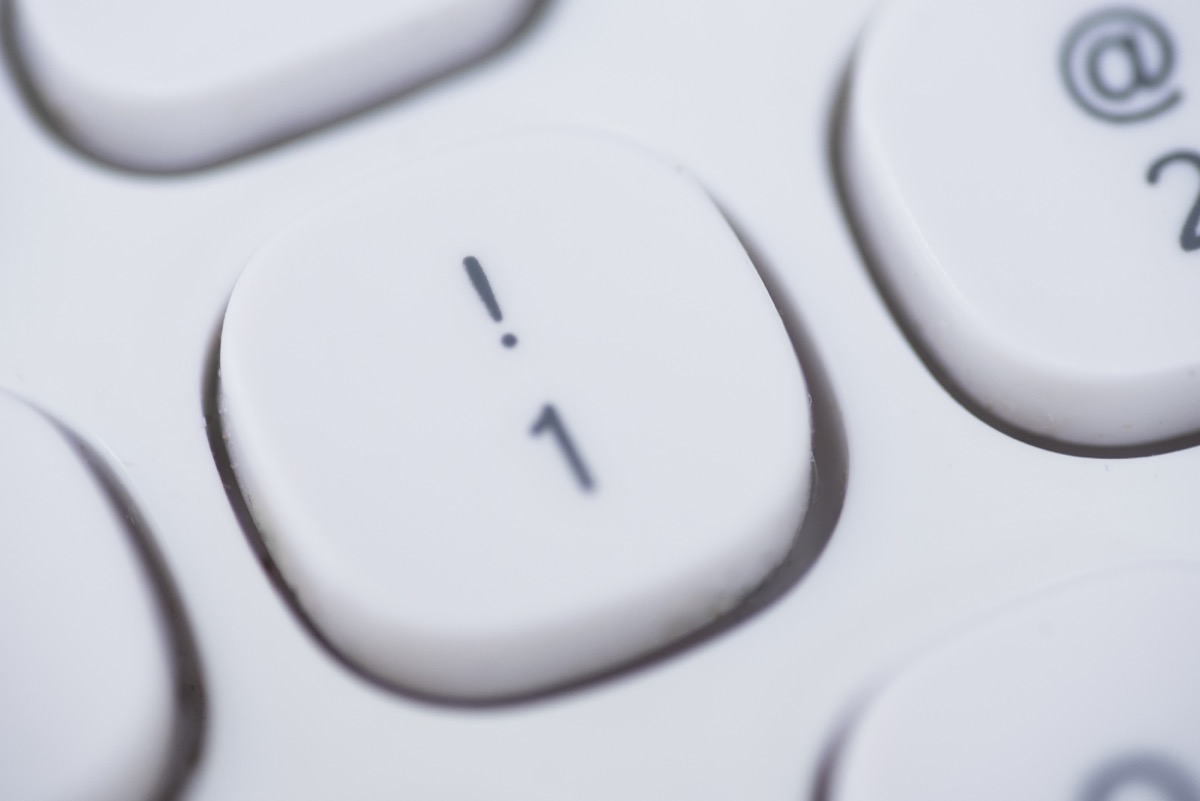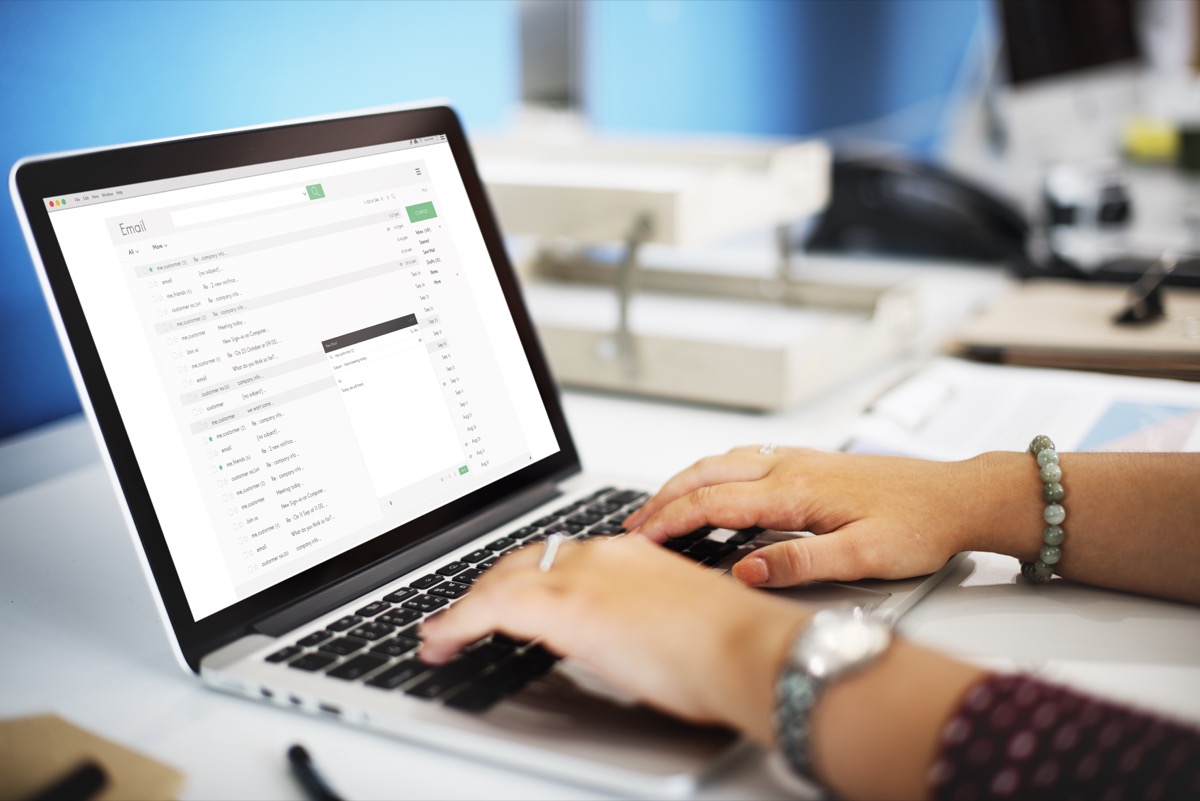17 Unwritten Email Etiquette Rules No One Ever Taught You

When it comes to email, you may think you know all there is to know. After all, most of us send and receive an average of 121 emails per day, according to tech market research firm The Radicati Group. But even though you likely spend a significant chunk of each day toiling in your inbox, you still could probably learn a thing or two. Actually, there are a ton of email etiquette rules that regularly elude you and plenty of other people in your contact list. Want to be sure you’re being electronically polite? Here are the 17 golden rules of emailing you probably didn’t know, but need to know.
1
Respond the minute you get an email, even if you need more time.

No one appreciates receiving a response to an email weeks after they sent it. In fact, a 2018 survey conducted by consultant firm Toister Performance Solutions revealed that 41 percent of people expected an email response from their coworkers in under an hour. (Start drafting apology notes to your accounting department now!)
Of course, some email responses call for you to chew over your thoughts, and draft up a measured message. In those cases, the solution is easy: Reply within minutes to let the sender know you received their message, but need a bit more time to sort things out. That way, they know you’ve taken their email into consideration and aren’t simply ignoring them.
2
Use “Reply All” with caution.

There’s a crucial difference between the “Reply” and “Reply All” options. And yet, many email users unfortunately don’t realize that. In case you’re one of them, know that when you choose the latter, every recipient who was CC’d on the original message receives your response—and, more often than not, you needn’t flood everyone’s inboxes.
These unnecessary mass messages are such a scourge, there’s a colloquial term to describe them: “Reply Allpocalypse.” So, next time you’re responding to a mass email, consider who really needs to read your response: the whole company or just the original sender?
3
If you want a response from someone, don’t CC them.

When you CC someone on an email—which means you’re “carbon copying” them—it typically indicates that you want to keep them looped in on the conversation, but aren’t necessarily looking for a response from them. And, as training professional Dannielle Walz warns, misusing the CC option can lead to communication issues.
“By CC-ing your colleagues into many emails, they may begin to stop seeing your emails as important and may place them directly into a ‘reference folder’ or ‘read later folder,'” she wrote in a LinkedIn post. “This may lead to important information being missed in the future.”
So, if you expect a response from someone, put their email address in the “To” field, and use the “CC” function sparingly.
4
Understand when and when not to use BCC.

The BCC field is even more complicated, constantly evading even the most seasoned email users. But let’s break it down: BCC stands for “blind carbon copy,” so, while it’s similar to CC-ing, BCC-ing doesn’t display that person’s email to other recipients, meaning no one else on the chain will see that you included them.
So when is it okay to use BCC? Hillel Fuld of Inc. magazine says it’s strictly for mass emails or when someone introduces you via email to someone else.
“In every other case, when you email someone and BCC someone else, you’re being dishonest—like it or not,” Fuld notes. “You are emailing Person X and without them knowing, letting Person Y eavesdrop on your conversation. Person X has no idea that someone else is reading this email, when in reality, you secretly sent it to someone else as well.”
5
Use exclamation marks sparingly.

It’s easy to throw an exclamation mark in your emails here and there, but try not to make a habit of it. While they’re historically used to indicate excitement, in an email, exclamation marks can easily be mistaken for phoniness or passive aggressiveness.
“Use of the unnecessary exclamation mark in [an] email can easily destroy the underlying meaning of your text,” Anna Verasai explains on HR Digest. “Use it only when you need to emphasize something that is important. Think about how your reader might interpret the message when they read it.”
6
Be cautious with your use of humor.

Everyone loves a good joke every now and then, but because tone can be misconstrued when not corresponding in-person, it’s best to leave the jokes out of your emails. “Reserve the humor for a phone call or in person,” business writing professor, David Silverman, wrote in the Harvard Business Review. “That way, when there’s stunned silence on the other end of the line or on the far side of the conference table, I could say, ‘I think you may not realize how funny I consider myself to be, and, given that, I believe I will stop now.'”
But seriously: A pivotal 2005 study published in the Journal of Personality and Social Psychology revealed that, while senders predicted that their recipients could accurately decipher their tone 80 percent of the time, the recipients were actually only able to accurately read tone 56 percent of the time.
7
Skip the slang.

With the rise of instant messaging, shortened forms of the English language have become more widely used—like “u” for “you,” or “wanna” instead of “want to.” But, just like humor doesn’t often stick when it comes to emails, slang is a similar no-go. According to one OnePoll survey, 37 percent of people thought slang usage in the workplace was unacceptable, and 55 percent said skip the “lol” when it comes to emailing your boss.
8
Pay attention to the subject line.

Subject lines are simple, but necessary. And since a majority of emails are read on mobile devices—55 percent, according to email deliverability company Return Path—it’s important to nail them. Short, concise, and direct subject lines are best. The purpose of your email should be clearly stated and you should limit it to five words or fewer, because mobile devices cut off any words after that.
9
Include a signature.

Have you ever gotten an email from someone and wondered, “Who is this from?” Though the sender’s address can give you a few clues as to who they are, sometimes it’s not enough. A signature at the end of your email can immediately inform the recipient of who you are, what you do, and how they can further contact you.
The folks at integrated marketing agency Ocreative say that having an email signature box is “like handing a person a business card every time you send an email.” If you don’t have one yet, add a signature that includes your full name, position, phone number, email, website, and a business logo.
10
Remember to KISS (keep it short and simple).

The KISS method is something most of us were taught in elementary school, but that doesn’t mean it’s any less necessary later in life. Boomerang, an email productivity app, researched the key methods to getting more email responses. Their biggest takeaway? It’s best to write like you’re eight years old.
Their research found that emails that were written at a third-grade reading level were 36 percent more likely to be responded to than ones written at a college reading level.
11
Bring attention to the attachments.

Attachments are sometimes a necessary part of the email process, but you should know full well how to use them before attaching with abandon. In long email chains, they can sometimes go unnoticed or overlooked, and unexpected attachments tend to also be unopened because recipients are wary of electronic viruses.
The best solution is to call out your attachments in the body of your email. Grammarly says the best way to notify the recipient of attachments is to include a message at the end of your email that says something along the lines of “I’ve attached [item]” or “Please refer to the attached [item] for more details.”
12
Standardize your font.

While playing around with font styles and colors can be fun, there’s no place for bright pink Comic Sans in the professional world. As it turns out, font usage is extremely important when it comes to digital communication, according to Colin Wheildon, author of Type & Layout: Are You Communicating or Just Making Pretty Shapes? “It’s possible to blow away three-quarters of our readers simply by choosing the wrong type,” he told American Writers & Artists.
So what fonts should you be sticking to when it comes to emails? MageMail recommends Georgia, Verdana, Times New Roman, Trebuchet MS, or Arial.
13
Proofread everything.

When writing an email, chances are, you’re going to make a mistake; after all, you’re only human. However, mistakes aren’t often looked past when it comes to work emails. In a Grammarly poll of nearly 2,000 respondents, 67 percent said it was not okay to make typos in emails, while only 6 percent thought it was an acceptable mistake.
14
Enter the email address last.

The easiest way to make sure you don’t send an email before it’s ready or before it’s been cleared of any typos? Wait until everything is in tip-top shape before entering the recipient’s email address. As you know, making email mistakes is one of the easiest ways to make the wrong impression.
“It’s not just professionalism that’s the issue,” Karen Kessler, president of Evergreen Partners, told Forbes. “What is at stake is the reputation of the employee and the company or organization. We’ve seen poor email decisions lead to negative consequences for the employee—dismissal—and for the organization as well—litigation.”
15
And triple-check your recipient’s name.

One big mistake you should avoid is spelling your recipient’s name wrong, so make sure to triple-check before you hit send. Many people see the act of misspelling a name as lazy and inconsiderate, especially when the correct spelling is in the email address. What should you do if you do accidentally make that mistake? Kathryn Shanley, owner of My Red Pen Editing, says an immediate apology is the key to maintaining your credibility.
16
For professional business, use a professional email address.

While a personal email address is fine to use when corresponding with friends or family, keep it out of the professional business realm. This is especially important in a consumer-seller situation. A 2016 GoDaddy survey of 1,000 Americans revealed that 75 percent believe that having a professional email is an important factor in trusting an online business, and 33 percent would doubt the legitimacy of a seller if they used a personal email address.
“You never forget a first impression, either in real life or online,” GoDaddy’s chief product officer, Steven Aldrich, said in a statement. “Often your first direct interaction with a customer takes place over email and so looking professional in this context is hugely important.”
17
Remember that anything can be shared.

Whether it’s through forwarding, BCC-ing, or simply flashing your phone in someone’s face, it’s important to remember that anything you write in an email can be seen by someone other than the intended recipient. Therefore, all your e-communication should be professional and risk-free. After all, emails can even be admissible in court, so it’s best to never send anything that could be used against you later. And for more ways to improve your work life, check out the 25 Genius Tricks for Working Smarter and Not Harder.
To discover more amazing secrets about living your best life, click here to follow us on Instagram!